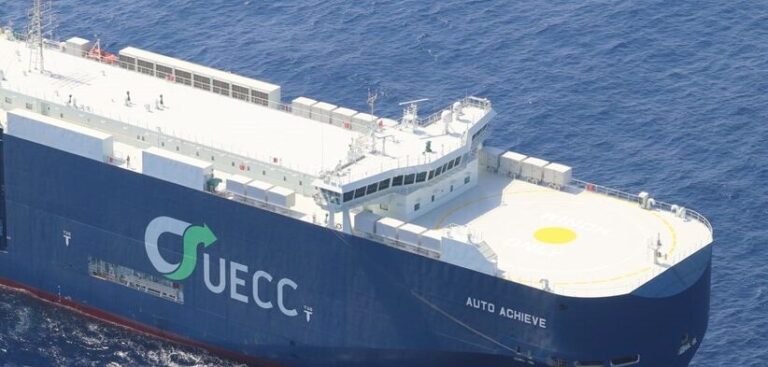UECC has unveiled the third of its trio of new-build green-powered pure car and truck carriers (PCTC) in a naming ceremony at the port of Gothenburg in Sweden.
The Auto Achieve is a battery hybrid PCTC. It also features a multi-fuel engine that was designed to run initially on environmentally friendly liquified natural gas (LNG) but is also adaptable to low-carbon fuels such as bio-LNG. The configuration is assisted by a smart energy management system.
The battery power on the new vessel is expected to improve operational efficiency and reduce emissions through peak shaving. A shaft generator enables the ship to recharge its batteries at sea so it can run the bow thruster in and out of port solely on battery power. The use of a battery hybrid solution will enable UECC to exceed the International Maritime Organization (IMO) target to reduce carbon intensity by 40% from 2008 levels by 2030. The use of LNG will reduce CO2 emissions by around 25%, sulfur oxide (SOX ) and particulate matter by 90% and NOX by 85%. The new-build will also meet the IMO’s Tier 3 NOx emissions limitations for the North Sea and Baltic Sea.
The vessel concept was created in 2017 and subsequently developed in cooperation with Jiangnan Shipyard’s in-house design institute before the first new-build orders were issued in early 2019. The yard had to contend with labor and logistical difficulties due to Covid-19 lockdowns and travel restrictions, which hit manpower capacity and led to supply-chain disruption. However, the vessels were delivered within the schedule.
Two of the sister ships – Auto Advance and Auto Achieve – have already begun operating in northern European waters; the Auto Aspire will follow shortly.
Glenn Edvardsen, chief executive of UECC, said, “I want to pay tribute to the hard work, dedication and expertise of the engineering team along with the entire workforce at Jiangnan Shipyard to realize the challenging project. Design and construction of these vessels represent a remarkable feat of engineering, teamwork and international cooperation, which enabled us to overcome not only technical but also logistical challenges to bring this new-build project to fruition. To achieve change, we have to boldly move forward with new ideas today that can solve the challenges of tomorrow.
“The climate crisis is one of the biggest challenges facing mankind, and shipping currently accounts for over a tenth of CO2 emissions from transport and about 3% of total global emissions. The industry can be part of the climate solution by proactively adopting new green technology and low-carbon fuels to meet this challenge. Together, we are demonstrating that change is possible by daring to be the difference.”



